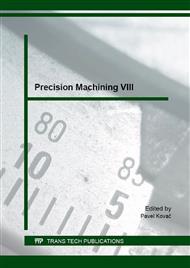[1]
L. Jaworska, Diament, otrzymywanie i zastosowanie w obróbce skrawaniem, WNT, Warszawa, (2007).
Google Scholar
[2]
L.A. Dobrzański, Podstawy nauki o materiałach i metaloznawstwo: Materiały inżynierskie z podstawami projektowania materiałowego, WNT, Warszawa, 2002, 878-910.
Google Scholar
[3]
T. Miyamoto, J. Fujiwara, K. Wakao, Influence of WC and Co in Cutting Cemented Carbides with PCD and CBN Tools, Key Engineering Materials 407 (2009) 428-431.
DOI: 10.4028/www.scientific.net/kem.407-408.428
Google Scholar
[4]
H. Tanaka, S. Shimada, N. Ikawa, M. Yoshingaga, Wear Mechanism of Diamond Cutting Tool in Machining of Steel, Key Engineering Materials 196 (2001) 69-78.
DOI: 10.4028/www.scientific.net/kem.196.69
Google Scholar
[5]
F.A. Almeida, A.J.S. Fernandes, F.J. Oliveira, R.F. Silva, Semi-orthogonal turning of hardmetal with CVD diamond and PCD inserts at different cutting angles, Vacumm 83 (2009) 1218-1223.
DOI: 10.1016/j.vacuum.2009.03.029
Google Scholar
[6]
G. Byrne, D. Dornfeld, B. Denkena, Advancing Cutting Technology, CIRP Annals – Manufacturing Technology 52 (2003) 483-507.
DOI: 10.1016/s0007-8506(07)60200-5
Google Scholar
[7]
Z.J. Yuan, Y.X. Yao, M. Zhou, Q.S. Bal, Lapping of single crystal diamond tools, CIRP Annals – Manufacturing Technology 52 (2003) 285-288.
DOI: 10.1016/s0007-8506(07)60585-x
Google Scholar
[8]
G.T. Smith, Cutting Tool Technology Industrial Handbook, Springer-Verlag London, (2008).
Google Scholar
[9]
W. Grzesik, Machining of Hard materials, Springer-Verlag London, 2008, 97-105.
Google Scholar
[10]
S.C. Shaf, P.M. George, Surface Roughness Modeling in Precision Turning of Aluminium by Polycrystalline Diamond Tool Using Response Surface Methodology, International Journal of Emergency Technology and Advanced Engineering 5(2).
Google Scholar
[11]
S.J. Heo, Environmentally conscious hard turning of cemented carbide materials on the basis of micro-cutting in SEM (2nd report): stress turning with three kinds of cutting tools, Journal of Mechanical Science and Technology 23 (2009).
DOI: 10.1007/s12206-009-0512-3
Google Scholar
[12]
F. Kolcke, Cutting Tool Materials and Tools, Manufacturing Process, Springer-Verlang Berling, (2011).
Google Scholar
[13]
Q. Bai, Y. Yao, S. Chen, Research and development of polycrystalline diamond woodworking tools, International Journal of Refractory Metals and Hard Materials 20 (2002) 395-400.
DOI: 10.1016/s0263-4368(02)00060-4
Google Scholar
[14]
F. Nabhani, Wear mechanisms of ultra-hard cutting tools materials, Journal of Materials Processing Technology 115 (2001) 402-412.
DOI: 10.1016/s0924-0136(01)00851-2
Google Scholar
[15]
M.J. Jackson, W. Ahmed, Machining of Brittle Materials Using Nanostructured Diamond Tools, Machining with Nanomaterials, Springer (2009) 1-30.
DOI: 10.1007/978-0-387-87660-3_5
Google Scholar
[16]
W. Zębala, R. Kowalczyk, Estimating the effect of cutting data on surface roughness and cutting force during WC-Co turning with PCD tool using Taguchi design and ANOVA analysis, International Journal of Advanced Manufacturing Technology 77 (2015).
DOI: 10.1007/s00170-014-6382-6
Google Scholar
[17]
W. Zębala, R. Kowalczyk, Cutting data influence on cutting forces and surface finish during sintered carbide turning, Key Engineering Materials 581 (2014) 148-153.
DOI: 10.4028/www.scientific.net/kem.581.148
Google Scholar
[18]
W. Zębala, B. Słodki, Cutting data correlation in Inconel 718 turning, International Journal of Advanced Manufacturing Technology 65 (2013) 881-893.
DOI: 10.1007/s00170-012-4225-x
Google Scholar
[19]
W. Zębala, J. Gawlik, A. Matras, G. Struzikiewicz, Ł. Ślusarczyk, Research of surface finish during titanium alloy turning, Key Engineering Materials 581 (2014) 409-414.
DOI: 10.4028/www.scientific.net/kem.581.409
Google Scholar
[20]
A. Matras, W. Zębala, R. Kowalczyk, Precision milling of hardened steel with CBN tools, Key Engineering Materials 581 (2014) 182-187.
DOI: 10.4028/www.scientific.net/kem.581.182
Google Scholar
[21]
W. Zębala, B. Słodki, G. Struzikiewicz, Productivity and reliability improvement in turning inconel 718 alloy - case study, Eksploatacja i Niezawodnosc-Maintenance and Reliability, 15, 4 (2013) 421-426.
Google Scholar
[22]
J. Kundrák, G. Varga, Possibility of reducing environmental load in hard machining. Key Engineering Materials 496 (2011) 205-210.
DOI: 10.4028/www.scientific.net/kem.496.205
Google Scholar
[23]
D. Fratila, Sustainable manufacturing through environmentally-friendly machining, Springer, 2013, 1-21.
Google Scholar
[24]
J. Beňo, I. Maňková, M. Vrabeľ, D. Kottfer, Roughness measurement methodology for selection of tool inserts, Measurement 46, 1 (2013) 582-592.
DOI: 10.1016/j.measurement.2012.08.017
Google Scholar
[25]
S.T. Newman, A. Nassehi, R. Imani-Asrai, V. Dhokia, Energy efficient process planning for CNC machining, CIRP Journal Manufacturing Scientific Technology 5 (2012) 127-136.
DOI: 10.1016/j.cirpj.2012.03.007
Google Scholar
[26]
B. Mikó, J. Beňo, Effect of the Working Diameter to the Surface Quality in Free-form Surface Milling, Key Engineering Materials 581 (2014) 372-377.
DOI: 10.4028/www.scientific.net/kem.581.372
Google Scholar


